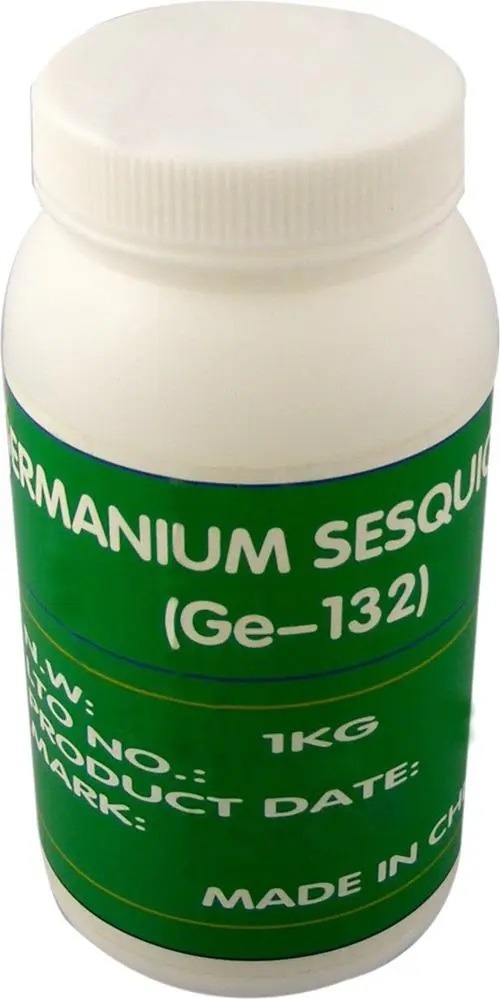I. Organic Germanium
Germanium (Ge), a chemical element with atomic number 32, occupies Group IVA in the fourth period of the periodic table. Organic germanium refers to a class of compounds where germanium atoms form covalent bonds with non-metallic elements such as carbon, hydrogen, oxygen, and nitrogen. These compounds are characterized by germanium-carbon bonds (Ge-C) in their molecular structure. Unlike inorganic germanium (e.g., germanium dioxide), organic germanium exhibits lower toxicity, higher biological activity, and demonstrates unique value in biomedicine and related fields.
Ge-132 (Carboxyethyl Germanium Sesquioxide):
Chemically termed β-carboxyethyl germanium sesquioxide with the molecular formula (GeCH₂CH₂COOH)₂O₃, Ge-132 represents one of the most extensively studied and applied organic germanium compounds. Its molecular structure features two carboxyethyl groups and three oxygen atoms bound to germanium, forming a stable cage configuration.
II. Efficacy of Organic Germanium
(I) Immunomodulatory Effects
1. Immune Cell Activation
Organic germanium significantly enhances the activity of macrophages, T lymphocytes (including helper and cytotoxic T cells), and natural killer (NK) cells. Macrophages—key phagocytes in the immune system—engulf pathogens, senescent cells, and abnormal cells. Research indicates organic germanium activates macrophage surface receptors, stimulating secretion of cytokines such as TNF-α, IL-1, and IL-6. These cytokines critically regulate immune responses, inflammation, and antitumor processes. For T lymphocytes, it promotes proliferation, differentiation, and cellular immunity, thereby strengthening host defense against viral and bacterial pathogens.
2. Immune Balance Regulation
During immune dysregulation (e.g., rheumatoid arthritis, systemic lupus erythematosus), the immune system erroneously attacks host tissues. Organic germanium demonstrates bidirectional immunomodulatory capacity: it suppresses hyperactive immune responses and reduces autoantibody production while enhancing immunity in immunocompromised states, restoring systemic equilibrium.
(II) Antitumor Mechanisms
1. Inhibition of Tumor Growth and Proliferation
Organic germanium impedes tumor growth through multiple pathways:
– Disrupting DNA synthesis/replication, arresting the cell cycle at the S-phase (DNA synthesis) to G₂-phase transition.
– Impairing mitochondrial energy metabolism, reducing ATP generation, and starving tumors of energy.
Studies confirm dose- and time-dependent growth inhibition across diverse cell lines (e.g., HepG2 hepatocarcinoma, A549 lung cancer, SGC-7901 gastric cancer).
2. Induction of Tumor Cell Apoptosis
Tumor cells evade programmed cell death to enable uncontrolled proliferation. Organic germanium activates apoptotic pathways (mitochondrial and death receptor routes), triggering:
– Loss of mitochondrial membrane potential
– Cytochrome c release
– Caspase protease activation
– Upregulation of pro-apoptotic genes (Bax) and downregulation of anti-apoptotic genes (Bcl-2).
3. Suppression of Tumor Angiogenesis
Tumor progression and metastasis require neovascularization. Organic germanium inhibits vascular endothelial cell proliferation/migration and downregulates vascular endothelial growth factor (VEGF) and its receptors, thereby starving tumors of nutrients.
4. Chemotherapy Synergy and Toxicity Reduction
Organic germanium potentiates chemotherapeutic agents (e.g., cisplatin, doxorubicin) while mitigating adverse effects (e.g., myelosuppression, gastrointestinal toxicity), likely via its immunomodulatory and antioxidant properties.
(III) Antioxidant Activity
1. Free Radical Scavenging
Metabolic free radicals (e.g., O₂⁻, ·OH) cause oxidative damage, contributing to aging, cardiovascular disease, diabetes, and cancer. Organic germanium’s hydroxyl/carboxyl groups directly neutralize radicals, protecting cellular membranes, DNA, and proteins.
2. Enhancement of Endogenous Antioxidant Enzymes
It upregulates antioxidant enzymes including superoxide dismutase (SOD), glutathione peroxidase (GSH-Px), and catalase (CAT). Chronic intake significantly elevates enzymatic activity, fortifying the body’s antioxidant defense system.
(IV) Metabolic Regulation
1. Glucose Metabolism
In diabetes, organic germanium:
– Enhances insulin sensitivity
– Promotes peripheral glucose uptake/utilization
– Suppresses hepatic glycogenolysis and gluconeogenesis
Animal and clinical studies demonstrate improved glycemic control and mitigation of complications (e.g., retinopathy, nephropathy).
2. Lipid Metabolism
It modulates lipid profiles by:
– Inhibiting cholesterol/triglyceride synthesis
– Promoting lipid catabolism/excretion
– Lowering LDL-C (“bad cholesterol”) while elevating HDL-C (“good cholesterol”)
Additionally, it suppresses adipocyte differentiation/proliferation, supporting obesity management and cardiovascular disease prevention.
(V) Additional Therapeutic Effects
1. Anti-Inflammatory Action
Suppresses inflammatory mediators (e.g., PGE₂, histamine), alleviating conditions like rheumatoid arthritis, gastritis, and hepatitis.
2. Microcirculation Improvement
Dilates blood vessels, reduces viscosity, and enhances tissue perfusion—beneficial for ischemic conditions (e.g., angina relief in coronary heart disease).
3. Wound Healing Acceleration
Stimulates epithelial/fibroblast proliferation and collagen synthesis, improving recovery in skin trauma and ulcers.
III. Applications of Organic Germanium
(I) Nutraceuticals
1. Immune-Boosting Formulations
Leveraging immunomodulatory effects, products target immunocompromised populations (e.g., elderly, high-stress individuals). Common formats: oral liquids, capsules, tablets (e.g., Ge-132 supplements).
2. Antioxidant/Anti-Aging Products
Counteracts age-related oxidative stress, improving skin integrity (reduced wrinkles/pigmentation) and vitality.
3. Metabolic Health Aids
Assists in glucose/lipid management for diabetics, dyslipidemia patients, and metabolic syndrome populations.
(II) Medical Applications
1. Oncology Adjuvant Therapy
Augments conventional treatments (surgery/chemotherapy/radiotherapy) by:
– Enhancing immunity
– Reducing treatment toxicity
– Inhibiting recurrence/metastasis
Shows promise in solid tumors (lung/liver/gastric cancers) via preclinical and limited clinical data.
2. Immune Disease Management
Modulates aberrant immunity in autoimmune disorders (e.g., rheumatoid arthritis), though further clinical validation is needed.
3. Other Therapeutic Uses
– Diabetes: Adjunctive glycemic control
– Cardiovascular disease: Lipid modulation + microcirculation improvement
– Chronic inflammation: Symptom alleviation
(III) Cosmetics
1. Skincare Products
Creams, serums, and masks utilize its antioxidant properties to combat photoaging, enhance skin elasticity, and accelerate keratinocyte turnover.
2. Sunscreen Formulations
Provides UV absorption and combats radical damage induced by ultraviolet exposure.
(IV) Other Fields
1. Agriculture & Animal Husbandry
– Crops: Growth promoter and stress resistance enhancer
– Livestock: Feed additive for improved immunity/growth performance
2. Food Additives
Incorporated into functional beverages/fortified foods for health benefits, subject to regulatory compliance.
IV. Safety and Precautions
(I) Safety Profile
Organic germanium exhibits low toxicity at recommended doses. Excessive intake may cause:
– Gastrointestinal distress (nausea, vomiting, diarrhea)
– Neurological symptoms (headache, fatigue)
– Hepatorenal impairment (severe cases)
Compound-specific toxicity necessitates strict dosage control.
(II) Usage Guidelines
1. Dosage Compliance
Adhere to product labeling or medical supervision. Special populations (pregnant/nursing women, children, elderly) require clinician guidance.
2. Drug Interactions
May alter pharmacokinetics of concomitant medications (e.g., chemotherapeutics). Professional oversight is essential to manage synergism/adverse effects.
3. Regulatory Adherence
Use only approved, quality-assured sources compliant with regional safety standards.

Leave A Comment